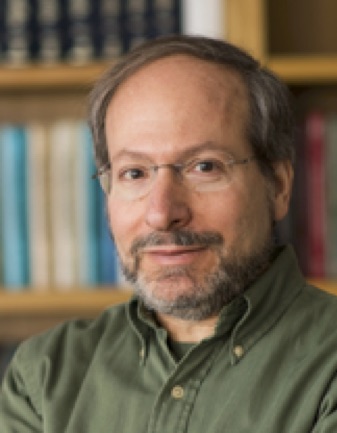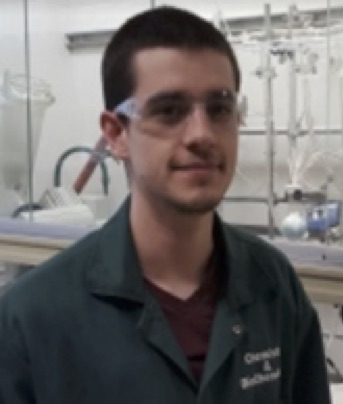Org. Synth. 2016, 93, 245-262
DOI: 10.15227/orgsyn.093.0245
Synthesis of 1-Iodopropyne
Submitted by Samuel G. Bartko, James Deng, and Rick L. Danheiser
*1
Checked by Joshua Cox and John L. Wood
1. Procedure
1-Iodopropyne (1). A 1-L, three-necked, round-bottomed flask is equipped with an overhead mechanical stirrer with a 19 x 60 mm teflon paddle, a 125-mL graduated pressure-equalizing addition funnel topped with a rubber septum with an argon inlet needle, and a rubber septum equipped with a thermocouple probe (Notes
1 and
2) (see Figure 1). The flask is charged with 150 mL of
THF (
Note 3), cooled in a dry ice/acetone bath, and
1-bromo-1-propene (15 mL, 21 g, 174 mmol, 1.5 equiv) (
Note 4) is added in one portion by syringe. The resulting solution is cooled to -73 °C (internal temperature) and
n-BuLi solution (114 mL, 293 mmol, 2.2 equiv) (
Note 5) is added dropwise via the graduated addition funnel at such a rate so as to maintain the internal temperature between -58 and -63 °C (
Note 6). The walls of the addition funnel are rinsed with two 5-mL portions of
THF delivered by syringe. The resulting pale yellow reaction solution is stirred further for 2 h at -73 °C (internal temperature), and a solution of
iodine (29.7 g, 117 mmol, 1.0 equiv) in 80 mL of
THF (
Note 7) is then added via cannula directly into the flask via the septum at such a rate so as to maintain the internal temperature between -58 and -63 °C (
Note 8).
Figure 1. Reaction Assembly
The resulting turbid brown solution is stirred at -73 °C (internal temperature) for 20 min, the dry ice/acetone bath is replaced with a room temperature water bath, and the reaction mixture is then allowed to warm to 0 °C (internal temperature) over 5 min. At this point a solution of 5.5 g of NaH2PO4 in 125 mL of deionized water is added to the reaction mixture via the addition funnel over 2 min (Note 9).
The contents of the reaction flask are transferred to a 1-L separatory funnel (the flask is rinsed with ca. 20 mL of
pentane and 20 mL of
water) (
Note 10) and the milky aqueous layer is separated and extracted with
pentane (3 x 50 mL). The combined organic layers are washed with 100 mL of saturated NaCl solution, dried over 10 g of
MgSO4 for ca. 10 min, and gravity filtered through filter paper with the aid of 25 mL of
pentane into a 1-L round-bottomed flask containing a 32 x 15 mm, Teflon-coated, oval magnetic stir bar. The filtrate is concentrated to a volume of approximately 25 mL by distillation at atmospheric pressure under argon (oil bath temperature gradually raised from 50 to 95 °C) through a 32-cm Vigreux column (Notes
11 and
12) into a 1-L flask cooled at 0 °C (see Figure 2).
Figure 2. Initial Concentration of Reaction Product Solution
The residual yellow solution (ca. 25 mL) in the distillation pot is transferred to a 50-mL, round-bottomed flask (containing a 13 x 8 mm, Teflon-coated, oval magnetic stir bar) using 10 mL of
pentane to rinse the 1-L flask. To concentrate the resulting solution, the flask is equipped with a 26-cm Vigreux column (
Note 11) topped with a short path distillation head with a 50-mL pear-shaped receiving flask (
Note 12). The receiving flask is cooled at 0 °C with an ice water bath (Figure 3). Distillation is carried out at atmospheric pressure, gradually raising the temperature of the oil bath until the vapor temperature at the distillation head reaches 85 °C. In this fashion, the
pentane and most of the remaining
THF and
hexane are removed by distillation, concentrating the product solution to a volume of ca. 20 mL. (Notes
13 and
14).
Figure 3. Further Concentration of Reaction Product Solution
The reaction product is then distilled using the setup shown in Figure 4 (
Note 12). The 50-mL flask containing the product is equipped with a 6-cm vacuum-jacketed micro Vigreux column (Figure 4) with a short-path distillation head attached to a 50-mL, three-necked, pear-shaped flask fitted with two glass stoppers secured with Teflon tape. The receiving flask is cooled in an ice water bath. Distillation of the product is carried out at atmospheric pressure under argon by raising the oil bath temperature from 25 to 130 °C over 30 min and then gradually from 130 to 150 °C over 30 min. The product is collected in a single fraction as 15.8-16.4 g (81-84%) of colorless liquid, 95% purity by QNMR (
Note 15). Although this material is sufficiently pure for most purposes, product with greater than 98% purity can be obtained by low-temperature recrystallization according to the following procedure.
Figure 4. Distillation of Iodopropyne
Low-temperature recrystallization of the distilled product is carried out using the setup shown in Figure 5. The three-neck receiving flask from the distillation is disconnected from the distillation head and the center neck is equipped with a rubber septum pierced with a metal spatula (Figure 6) and the left neck is equipped with a pressure-equalized, jacketed 50-mL addition funnel fitted with a rubber septum and argon inlet needle. The right neck is fitted with a rubber septum pierced with a 16-gauge cannula with filter paper secured onto the blunt end with Teflon tape (Figure 7) and connected to a 50-mL two-neck pear-shaped flask. Initially the end of the cannula filter is maintained above the level of the contents of the flask.
Figure 5. Set-up for Low-Temperature Recrystallization of Iodopropyne
Figure 6. Close-up of Septum Pierced with Spatula
Figure 7. Close-up View of Cannula Filter
Pentane (4.4 mL,
Note 16) is added to the three-necked flask by syringe and a homogeneous solution is obtained by stirring with the spatula. The flask is placed in an acetone bath, and small pieces of dry ice are gradually added to the bath to slowly lower the bath temperature to -78 °C over a period of 90 min. When crystal formation begins, the metal spatula is used to periodically scrape crystals from the sides of the flask and to break up aggregates of crystals. The mixture is maintained at -78 °C for an additional 90 min, using the metal spatula to stir and scrape the crystals as needed to prevent a single large aggregate mass from forming (Figure 8).
Figure 8. Appearance of Iodopropyne Crystals
The end of the cannula filter is then lowered to the bottom of the flask and the supernatant pentane is removed through the cannula by increasing the argon pressure (Note 17). The addition funnel is charged with 18 mL of pentane which is cooled to -78 °C by filling the jacket with dry ice/acetone. A portion of cold pentane (ca. 3 mL) is added to the crystals from the addition funnel, the cannula filter is raised above the level of the mixture, and the crystals are stirred with the metal spatula. The cannula filter is then lowered, a short outlet needle is inserted through the septum of the two-necked receiving flask, and the liquid is removed through the cannula by increasing the argon pressure. This washing process is repeated with five additional 3-mL portions of cold pentane. After removal of the last portion of pentane, the metal spatula is used to distribute the crystals along the walls of the flask so as to expose as much surface area as possible for subsequent drying.
With the flask still immersed in the dry ice/acetone bath, the addition funnel is rapidly replaced with an inlet adapter connected to a double manifold. The septa on the other necks (with metal spatula and cannula filter) are quickly replaced with glass stoppers, which are secured to the flask with Teflon tape (Note 18). Residual pentane is removed in vacuo (0.5-1.0 mmHg, 1 h) at -78 °C. The flask is back filled with argon, and the dry ice/acetone bath is replaced with a room temperature water bath. Upon warming to room temperature, the colorless crystals melt to afford 13.2 g (68%, >98% pure by QNMR) (Note 19) of 1-iodopropyne as a colorless liquid (Notes 20 and 21).
2. Notes
1. The reaction flask (equipped with the addition funnel) was dried in an oven (160 °C) overnight, assembled while hot, flushed with argon, and then maintained under an atmosphere of argon during the course of the reaction.
2. Mechanical stirring is preferred due to the formation of a precipitate in some runs at the stage of
iodine addition (vide infra). In these cases difficulties were encountered in maintaining stirring when magnetic stirring was employed.
3.
Tetrahydrofuran (ultra low water) was purchased from J. T. Baker and purified by pressure filtration through activated alumina prior to use. The Checkers used non-stabilized
THF, purchased from Fisher Scientific and passed through two packed columns of neutral alumina.
4.
1-Bromo-1-propene (mixture of E and Z isomers, 98%) was purchased from Sigma-Aldrich and distilled at atmospheric pressure under argon (bp 58-60 °C) prior to use. NMR analysis of the distilled
1-bromo-1-propene revealed a 3:1 ratio of
Z/E isomers.
5.
n-Butyllithium (2.58 M in hexanes) was purchased from Sigma-Aldrich and titrated prior to use.
2 The butyllithium was transferred to the addition funnel via cannula.
6. The addition of
n-BuLi solution required 30 min on this scale.
7.
Iodine (99.8%) was purchased from Alfa Aesar and used as received. The
iodine was weighed into a dry 100-mL two-necked, pear-shaped flask equipped with a magnetic stirbar and dissolved in 70 mL of
THF by stirring under argon for ca. 30 min. The
iodine solution was transferred to the reaction flask by cannula with the aid of two 5-mL portions of
THF to rinse the flask.
8. Initially the addition of the brown
iodine solution temporarily darkens the reaction mixture, which then returns to a pale yellow color. In some (but not all) runs a white precipitate was observed upon addition of the first drops of
iodine solution. Toward the end of the
iodine addition, the reaction mixture appears as a turbid brown solution. Addition of the
iodine solution required 15 min on this scale.
9. The addition of aqueous
NaH2PO4 solution leads to separation of the reaction mixture into a yellow top layer and a cloudy white bottom layer.
10.
Pentane (reagent grade, 98%) was purchased from Sigma-Aldrich and used as received.
11. The column length refers to the effective length, measured from the lowest to highest indent in the Vigreux column. The column is insulated with a wrapping of glass wool held in place with a covering of aluminum foil. Concentration through a 30-cm Vigreux column was found necessary to obtain clean separation of the solvents from
iodopropyne.
12. The Vigreux columns, distillation heads, and receiving flasks were all dried in an oven (160 °C) overnight and allowed to cool in a dessicator box before use.
13. The bath temperature initially is raised to 90 °C and held there for ca. 45 min while the
THF and
pentane distill (distillation head temperature 65-68 °C). The last of the solvent distills as the bath temperature is raised to 120 °C, and the distillation head temperature then falls to 25 °C. When the bath temperature is further raised to 130-135 °C, the
iodopropyne begins to distill (distillation head temperature increases from 25 to 85 °C) at which point the distillation is halted.
14. The Submitters report that quantitative
1H NMR spectroscopy (dimethyl terephthalate as internal standard) indicated that the residual orange liquid after concentration consists of 91%
1-iodopropyne, 2.1%
1-bromobutane, 1.8%
(E)-1-iodopropene (see Discussion Section), and trace amounts of
hexane and
THF (amounts not determined due to overlap with bromobutane resonances). It is assumed that several percent of polymeric material is present.
15. The material collected has bp 105-107 °C. The Submitters report that quantitative
1H NMR spectroscopy (dimethyl terephthalate as internal standard) indicated that the distilled product consists of 95%
1-iodopropyne, 2%
1-bromobutane, 1%
(E)-1-iodopropene, and trace amounts of
hexane and
THF (amounts not determined due to overlap with bromobutane resonances).
16. The Submitters found that best results were obtained in the recrystallization by using 0.25 mL of
pentane per 1 g of crude product.
17. It is important that all of the supernatant liquid is removed prior to adding the next wash of cold
pentane. The Submitters note that this was facilitated by stirring the crystals periodically with the spatula during the removal of liquid.
18. Shaking the cannula filter and spatula before removal from the flask may be necessary to dislodge any crystals that adhere to them.
19. A second run of the reaction at full scale provided 14.1 g (73%, >98% pure by QNMR) of the product.
20. At -78 °C the desired product is a colorless solid that melts at ca. -30 °C.
Iodopropyne is stable to storage under argon in the freezer (-20 °C) but turns pink when exposed to light.
21.
1-Iodopropyne (
1) has the following physical and spectroscopic properties:
1H NMR
pdf(CDCl
3, 400 MHz) δ: 2.02 (s);
13C NMR
pdf(CDCl
3, 150 MHz) δ -8.2, 5.8, 89.9; IR (thin film, ATR) 2959, 2915, 2848, 2197, 1438, 1012 cm
-1; HRMS (ESI)
m/z: Calcd. for C
3H
3I [M+H]
+: 166.9352, found: 166.9349. The purity was determined to be 98.4% by quantitative NMR spectroscopy with methyl salicylate as internal standard.
Working with Hazardous Chemicals
The procedures in
Organic Syntheses are intended for use only by persons with proper training in experimental organic chemistry. All hazardous materials should be handled using the standard procedures for work with chemicals described in references such as "Prudent Practices in the Laboratory" (The National Academies Press, Washington, D.C., 2011; the full text can be accessed free of charge at
http://www.nap.edu/catalog.php?record_id=12654). All chemical waste should be disposed of in accordance with local regulations. For general guidelines for the management of chemical waste, see Chapter 8 of Prudent Practices.
In some articles in Organic Syntheses, chemical-specific hazards are highlighted in red "Caution Notes" within a procedure. It is important to recognize that the absence of a caution note does not imply that no significant hazards are associated with the chemicals involved in that procedure. Prior to performing a reaction, a thorough risk assessment should be carried out that includes a review of the potential hazards associated with each chemical and experimental operation on the scale that is planned for the procedure. Guidelines for carrying out a risk assessment and for analyzing the hazards associated with chemicals can be found in Chapter 4 of Prudent Practices.
The procedures described in Organic Syntheses are provided as published and are conducted at one's own risk. Organic Syntheses, Inc., its Editors, and its Board of Directors do not warrant or guarantee the safety of individuals using these procedures and hereby disclaim any liability for any injuries or damages claimed to have resulted from or related in any way to the procedures herein.
3. Discussion
Halo alkynes serve as versatile building blocks for the construction of organic molecules and have found wide application in the synthesis of substituted alkynes including acetylenic natural products.
3 Nucleophilic addition and substitution reactions of halo alkynes have been known for many years,
3a and recently halo alkynes have been shown to function as reaction partners in [2 + 2] cycloadditions as well.
4 Most importantly, however, halo alkynes also participate in a variety of transition-metal catalyzed carbon-carbon bond forming reactions, including Cadiot-Chodkiewicz reactions leading to 1,3-diynes, "inverse Sonogashira couplings" for the synthesis of aryl acetylenes, syntheses of 1,3-enynes and aryl and hetaryl acetylenes via cross-coupling reactions with organoboron, -tin, and -zinc compounds, and NHK reactions with aldehydes. In addition, research in our laboratory and that of Hsung has led to the development of practical and efficient methods for the synthesis of ynamides via the N-alkynylation of various amine derivatives using bromo and iodo alkynes.
5Halo alkynes are most often prepared by dehydrohalogenation of 1,1-dihalo alkenes, via halogenation of terminal alkynes, and by the synthetic elaboration of metal halo acetylides (i.e., X-C≡C-Met).
2 In connection with a recent natural product total synthesis project in our laboratory, we required a practical method for accessing multigram quantities of 1-bromo- or
1-iodo-1-propyne. While these simple acetylenic halides have numerous applications as synthetic building blocks (vide infra), only the iodide is commercially available, and as of this writing
iodopropyne typically sells for $350-750 per gram.
Previously, Brandsma has reported the synthesis of 1-bromopropyne by the Straus reaction of
propyne gas with potassium hypobromite in a two-phase mixture of water and pet ether.
6 We found this procedure less than ideal for several reasons. In the first place,
propyne gas is expensive and rather inconvenient to handle. In addition, the product, 1-bromopropyne, is quite volatile (bp 64 °C) and has been reported to be dangerously reactive with air.
6 Iodopropyne, by contrast, is less volatile (lit. bp 109-110 °C) and is reported to be much more stable to air than the bromo derivative.
7Several laboratories have previously described the preparation of
1-iodopropyne. In 1943, Cleveland and Murray reported the generation of
1-iodopropyne by reaction of the Grignard derivative of
propyne with molecular iodine.
7 However, no yield was reported for this reaction which has the disadvantage of requiring the use of
propyne gas. Diner and Lown have reported the preparation of
iodopropyne from
propyne in 45% yield by reaction with an iodonium nitrate reagent.
8 Brandsma has described a more attractive route to
iodopropyne via reaction of 1,2-dibromopropane with lithium amide in liquid ammonia followed by addition of molecular iodine (Scheme 1).
9 While this procedure produces
iodopropyne in "excellent yield", it does require the handling of liquid ammonia and care must also be taken to avoid the formation of explosive nitrogen triiodide.
Scheme 1. Synthesis of Iodopropyne According to Brandsma
Robertson reported a more convenient route to
iodopropyne in 2012
10 involving a variant of the Hofmeister halo alkyne synthesis introduced by Isobe and coworkers.
11 As shown in Scheme 2, reaction of 1-(trimethylsilyl)propyne with
N-iodosuccinimide in the presence of AgNO
3 provided
1-iodopropyne in modest yield. While we regarded the Robertson approach to be the most attractive synthesis of
iodopropyne reported to date, we undertook the development of an alternative route that would not require the use of relatively expensive 1-(trimethylsilyl)propyne.
Scheme 2. Synthesis of Iodopropyne According to Robertson
Suffert has reported a convenient method for the generation of propynyllithium by the reaction of relatively inexpensive
(Z/E)-1-bromopropene with
n-butyllithium.
12 Propynyllithium generated in this fashion can be trapped with carbonyl electrophiles (aldehydes, ketones, acyl chlorides, and Weinreb amides)
12 or protonated to form solutions of
propyne that can then be employed in Sonogashira coupling reactions.
13 Suffert has suggested that this transformation proceeds via a mechanism related to the Fritsch-Buttenberg-Wiechell reaction, i.e., via deprotonation at the C-1 carbon of 1-bromopropene, followed by α-elimination and rearrangement to generate
propyne that then reacts with a second equivalent of butyllithium. The use of
n-butyllithium is crucial to the success of this method; with
s-butyllithium or
t-butyllithium halogen-metal exchange was reported to be a significant side reaction producing 1-propenyllithium that then reacts with the electrophilic trapping agent to afford substituted alkenes.
We anticipated that reaction of propynyllithium generated via the Suffert method with molecular iodine could provide an efficient, economical, and convenient route to 1-iodo-1-propyne. In the event, application of the Suffert chemistry for the synthesis of iodopropyne turned out to present certain practical challenges not encountered in reactions with the carbonyl electrophiles studied previously.
Scheme 3 outlines the optimal reaction conditions employed in the procedure described in this article. Not unexpectedly, the stoichiometry employed in the reaction proved to be important. For example, employing a larger excess of butyllithium led to the formation of 1-iodobutane and
n-octane, byproducts that proved difficult to separate from the desired
1-iodopropyne. The use of
THF as reaction solvent is also necessary, as reaction in diethyl ether proceeds very slowly as reported by Suffert.
12a
Scheme 3. Optimized Reaction Conditions
Development of an effective protocol for the isolation and separation of iodopropyne from trace byproducts required considerable experimentation. Careful distillation at atmospheric pressure was effective in separating the product (bp 105-107 °C) from THF and hexane, and provided material determined to be 95% pure by quantitative NMR analysis. The principal impurities were found to be 1-bromobutane and (E)-1-iodopropene, byproducts formed by halogen metal exchange of bromopropene with butyllithium and iodination of the resulting propenyllithium.
Separation of these byproducts from iodopropyne was not trivial as the boiling points of 1-bromobutane (102 °C) and 1-iodopropene (90 °C) are very similar to that of the desired product. Although distillation provides 1-iodopropyne with purity (95%) sufficient for many applications, we investigated the development of a procedure for separation of the iodopropyne from the trace byproducts. As described in this article, further purification of iodopropyne can be achieved by low-temperature crystallization from pentane, furnishing material in very good yield and with >99% purity.
Synthetic Applications of 1-Iodopropyne
A number of reports describe the application of
1-iodopropyne as a useful synthetic building block and as an intermediate in total syntheses of acetylenic natural products. For example, Mukai and coworkers employed a Cadiot-Chodkiewicz coupling of
iodopropyne in their syntheses of the endiyne natural product (-)-Al-2 and related compounds.
14 Similar coupling reactions were featured in Robertson's approach to the same class of natural products.
10Fürstner and Dierkes employed the coupling of an organocopper compound with
iodopropyne in their total synthesis of (
S,S)-(+)-dehydrohomoancepsenolide.
15 Mound et al. demonstrated that
iodopropyne can be coupled to aryl boronates under Suzuki conditions
16 and Vermeer et al. have reported the coupling of
iodopropyne with allenylcopper compounds to furnish allenynes.
17 Oxidative carbonylation of
iodopropyne has been reported by Bruk and Tempkin.
18 Finally, we have employed
iodopropyne in N-alkynylation reactions for the synthesis of ynamide benzannulation reaction partners.
19
Appendix
Chemical Abstracts Nomenclature (Registry Number)
1-Iodopropyne: 1-Propyne, 1-iodo; (1) (624-66-8)
1-Bromo-1-propene: 1-Propene, 1-bromo-; (590-14-7)
n-BuLi: n-Butyllithium; (109-72-8)
Iodine: Iodine; (7553-56-2)

|
Rick L. Danheiser received his undergraduate education at Columbia where he carried out research in the laboratory of Professor Gilbert Stork. He received his Ph.D. at Harvard in 1978 working under the direction of E. J. Corey on the total synthesis of gibberellic acid. Dr. Danheiser is the A. C. Cope Professor of Chemistry at MIT where his research focuses on the design and invention of new annulation and cycloaddition reactions, and their application in the total synthesis of biologically active compounds. |

|
Samuel G. Bartko was born in Littleton, Colorado and received a S.B. degree in Chemistry at the University of Wyoming in 2014. He is currently pursuing a Ph.D. degree in the Department of Chemistry at the Massachusetts Institute of Technology under the direction of Professor Rick Danheiser. The main focus of Sam's current research is the development of new strategies for the efficient synthesis of highly substituted pyridines based on cycloadditions of highly conjugated molecules. |

|
James Deng was born in New Haven, Connecticut and is currently an undergraduate chemistry major at the Massachusetts Institute of Technology and is expecting to graduate with a B.S. degree in chemistry in 2017. James joined the laboratory of Professor Danheiser as an undergraduate researcher in January 2014 with his main project focusing on the investigation of synthetic routes to bioactive polyacetylene natural products. |

|
Joshua Cox received his B.S. degree from Texas A&M in chemistry in 2014. He is currently pursuing a Ph.D. degree in the Department of Chemistry at Baylor University under the direction of John L. Wood. |
Copyright © 1921-, Organic Syntheses, Inc. All Rights Reserved